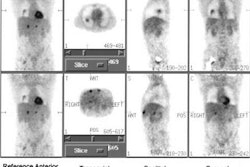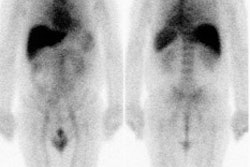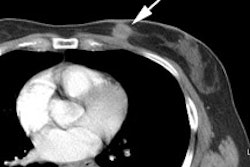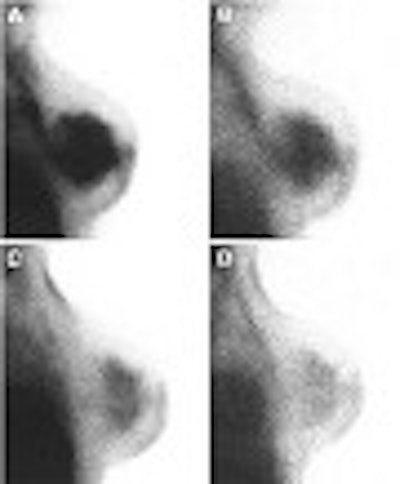
One of the major reasons for failed breast chemotherapy is bioresistance to the treatment course. Breast scintigraphy may be able to predict whether a patient will respond favorably to chemotherapy, and can help shape the treatment protocol, according to a study in the latest issue of the Journal of Nuclear Medicine.
At the Regency Elena Cancer Institute in Rome, Italy, nuclear medicine specialists teamed up with oncologists and pathologists to evaluate the prognostic value of 99mTc-sestamibi washout for predicting the response to neoadjuvant chemotherapy in locally advanced breast cancer.
"Chemoresistance is a multifactorial phenomenon including several nonspecific and specific mechanisms. The term multidrug resistance (MDR) is commonly used to indicate an overexpression of transmembrane glycoproteins...knowledge of the MDR pattern before and during the treatment can improve therapy planning, including selection of drug-resistant patients for chemorevertant drugs," wrote lead author Dr. Rosa Sciuto (JNM, June 2002, Vol. 43: 6, pp. 745-751).
Thirty women with untreated, locally advanced breast cancer were enrolled. Before starting chemotherapy, all patients underwent a baseline evaluation consisting of a clinical exam, bilateral mammography, fine-needle aspiration cytology or histologic biopsy of the lesion, bone scintigraphy, standard chest x-ray, liver sonography, and a basal 99mTc-sestamibi study.
At the end of chemotherapy, the patients were reevaluated clinically, with mammography, and with scintigraphy. The protocol for the latter was as follows: 740 MBq of 99mTc-sestamibi (Cardiolite, Bristol-Myers Squibb Medical Imaging, North Billerica, MA) were injected intravenously in the arm contralateral to the lesion. Early and delayed digital planar images of the breast region were acquired with the patient prone (lateral views) and supine (anterior views). A large field-of-view gamma camera equipped with a high-resolution low-energy parallel-hole collimator and a dedicated foam-rubber mattress was used (Prism 2000 XP, Philips Nuclear Medicine, Milpitas, CA).
All patients underwent radical mastectomy and axillary lymphadenectomy. The removed tumors and nodes were pathologically evaluated.
"The predictor of variable of chemoresistance was considered 99mTc-sestamibi washout in the pre-therapy study," the authors wrote. "The washout rate (WOR) was computed by the ratio of delayed to early uptake index, with decay and background correction."
The prediction of tumor response to therapy was based on the WOR from the first scintigraphy exam. The test was deemed positive if it predicted a high expression of intrinsic chemoresistance and a high risk of no tumor response. The pathologic outcome was classified as positive if residual tumor size was reduced by >75%.
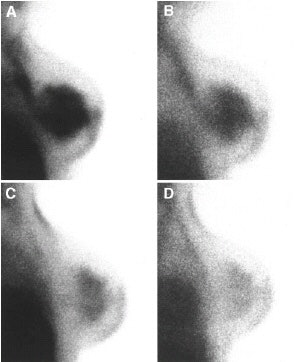 |
| Pre-therapy (early image A, delayed image B) and post-therapy (early image C, delayed image D) 99mTC-sestamibi studies of a patient who showed no response to chemotherapy at pathologic examination. Pretherapy studies show evidence of high 99mTC-sestamibi washout rate, predicting high MDR expression. Image C confirms negative response to chemotherapy; image D shows evident decrease in tracer uptake. |
According to the results, WOR ranged from 14%-92%. The test was positive for 18 of 30 patients who had a WOR >45% and negative for 12 patients with a WOR <45%. After surgery, half of the 30 patients had no response to chemotherapy, while the other half had a positive response.
Scintigraphic response was negative in 16 patients and positive in 14, correctly identifying 29 of 30 pathologic outcomes for an accuracy rate of 97%. On the post-therapy exams, scintigraphy studies confirmed the prediction of the pre-therapy exams for all but one of the 30 patients.
"A positive correlation was found between the efflux rate of 99mTc-sestamibi and P-glycoprotein expression or lack of response to chemotherapy. Retention of 99mTc-sestamibi appeared to also correlate with chemosensitivity to (anti-neoplastic chemotherapeutic drugs)," the authors wrote.
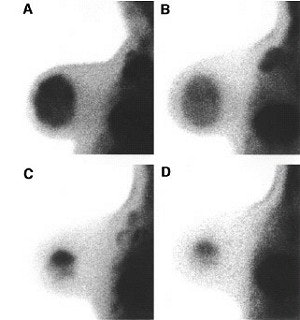 |
| Pre-therapy (early image A, delayed image B) and post-therapy (early image C, delayed image D) 99mTC-sestamibi studies of a patient who showed positive response to chemotherapy. Image A demonstrates intense and diffuse tracer uptake in the tumor and the axillary nodes, while image B predicts low MDR expression. Image C confirms positive response, showing small area of residual tracer uptake which remained substantially unchanged in image D. Images courtesy of the Journal of Nuclear Medicine. |
In addition to its 100% negative predictive value, the value of this protocol is that it is easily reproducible: It only requires two sequential planar images and a WOR index that is simple to calculate, they concluded.
Other research on the imaging of chemotherapy response will be presented at the 2002 Society of Nuclear Medicine meeting in Los Angeles next week. Investigators from the University of California, Los Angeles used FDG-PET and fluoro-l-thymidine PET (FLT-PET) to monitor the effects of breast cancer treatment. They found that the uptake of FLT was more sensitive to the early effects of chemotherapy than the uptake of FDG (Poster No. 1253).
By Shalmali PalAuntMinnie.com staff writer
June 13, 2002
Related Reading
Postmastectomy radiation may be warranted after response to chemotherapy, February 1, 2002
MRI beats US, mammo for tracking breast tumor response, January 7, 2002
Scintimammography finds its place in dense breasts, August 30, 2001
Scintimammography may back up x-ray mammo better than US, August 26, 2001
Copyright © 2002 AuntMinnie.com




